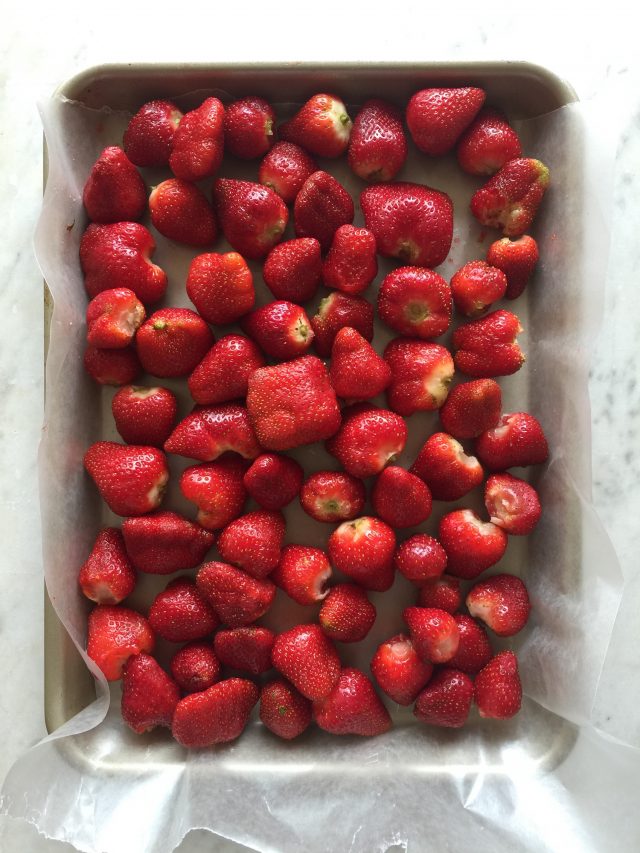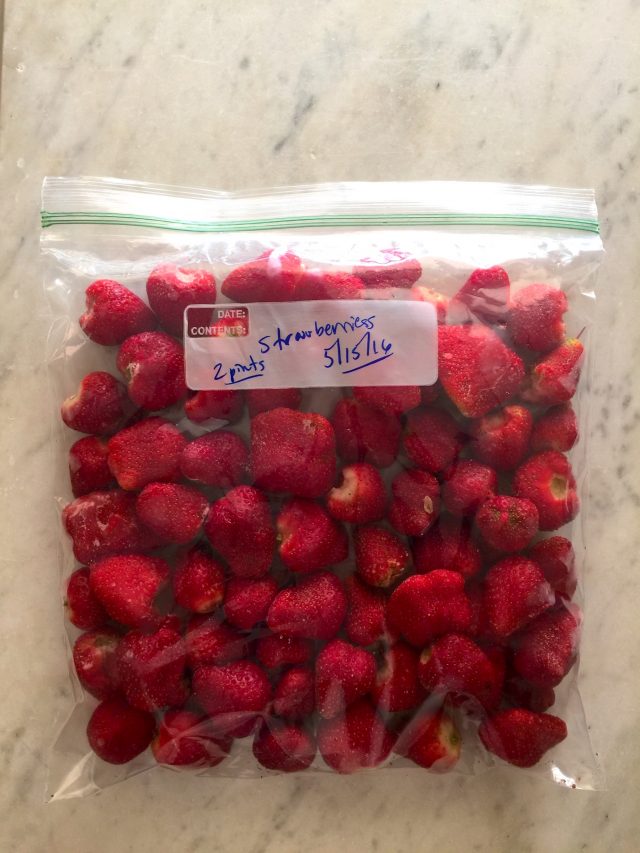How to Freeze Fresh Strawberries

I know, you’re thinking this is a no-brainer—the business of how to freeze fresh strawberries. Pop some in a bag, tuck it in the freezer, and you’re ready to go. In a way it really is that easy, but I find these few tips to be extra helpful to extend the strawberry season well beyond the last one is picked.
A few weeks ago, I read a tip at the farmers’ market about cleaning strawberries. I’d never heard it before, and was curious to give it a try. The farmer suggested mixing 10 parts water with 1 part vinegar, then swishing the berries around to remove any dirt. It doesn’t impart a vinegar flavor, and extends the shelf life of your strawberries. I found it to be quite successful, and have been doing so, instead of simple rinsing them with plain water.
Not every farmer will agree with this, and I’m sure a few you are raising your eyebrows, too. While in North Carolina this weekend, I overheard a farmer tell someone not to wash their strawberries, so go figure. Personally, I also like the idea of the vinegar solution from a sanitary perspective—I’m a major germaphobe. I wonder if there’s enough vinegar to make any real difference? I say you should rinse (or not rinse) your strawberries as you see fit. To each their own, right?
When it comes to freezing fresh strawberries, though, I do think following these 3 tips will set you up for success when you want to actually use them.
- Pluck the stems (also called hulling) before freezing strawberries. I can’t tell you how many times I’ve regretted my momentary laziness for not doing this step. It’s much easier to remove the stems from fresh strawberries, than frozen ones (and makes for quicker smoothies on busy weekday mornings).
- Lay strawberries, single layer, on a lined baking sheet (waxed paper or parchment work well). Freeze them until firm (this is called flash freezing, and works with veggies, too), then transfer to a container or ziptop bag, and store in the freezer until ready to use.
- Always label, date and note the volume or weight. This is a good rule of thumb for whatever goes into the freezer, and this goes for fruit, too. Sure it’s easy to see what’s inside, but including the date ensures you rotate your stock, always using the oldest first. Noting how much you have available avoids last minute runs to the grocery store.


Lea
Really, 10 parts vinegar to one water?! Seems it would be the other way around.
Carolyn
Do you do the vinegar rinse before freezing?
Radhika
Life’s best moments are the simple ones. Same with posts. I love the simple ones likes these. I learn so much. I love your Snaps as well. Eager to get back to one day having a garden again.
Elyse
The vinegar is supposed to keep the strawberries from molding as quickly as they are prone to if refrigerated.
Jennie
Thank you for sharing that info, Elyse!
xo-Jennie
Jennie
Yes, Carolyn. Sorry if that wasn’t clear.
Cindy
I leave my stems and leaves on when I use strawberries in smoothies. I learned that from the vitamix group on FB. It makes it easier and gives you a few extra greens. You’ll never know they are in there!
Rosemary
Thanks for this post. I have read it is best to wash berries only when they are going to be used. Do you advise freezing them washed or unwashed?
Jennie
I freeze them after they’re washed, Rosemary.
xo
Jennie
I just read an article about that, too, which noted to use the stems if the berries are organic. Thanks for sharing the info here. 🙂
I will likely still remove my stems because I’d like the option to use them for baking, too. But your reminder might inspire me to keep a separate bag with the stems to add to smoothies!
-Jennie
Amy
I keep a spray bottle full of a water/vinegar solution that I use to wash fruit. Cleans and removes pesticides better than water alone.
Jennie
Thanks for sharing this tip, Amy!
-Jennie